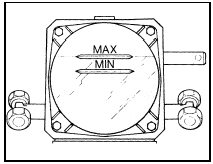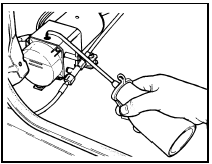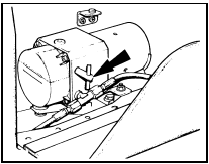Power-operated folding roof - fluid level checking and bleeding
General
1 As from 1987, a power-operated folding
roof is available as an option on Cabriolet
models.
2 The roof is operated hydraulically from an electric pump located in the left-hand side of the boot. Hydraulic rams, mounted on each side of the vehicle by the rear wheel housings, actuate the roof folding mechanism. A control switch is mounted on the centre console. In the event of failure, the roof can be operated manually by opening a bypass valve on the side of the pump.
3 The system is sealed and requires no regular maintenance apart from periodic checking of the fluid level.
Fluid level checking
4 The level should be checked with the roof
open. With the roof in the closed position, the
level will be lower due to the displacement of
the hydraulic rams.
5 Pull down the trim panel/pump cover on the left-hand side of the boot.
6 Check that the fluid in the reservoir on the end of the pump is between the “MIN” and “MAX” marks on the sight glass (see illustration).

23.6 Fluid level sight glass for poweroperated folding roof
7 If the level requires topping-up, remove the filler plug from the top of the pump reservoir and fill the reservoir with the specified fluid until the level reaches the “MAX” mark (see illustration).

23.7 Filling the power-operated folding roof fluid pump reservoir
8 Refit the filler plug and trim panel.
Bleeding
9 Open the bypass valve on the side of the
pump body (see illustration).

23.9 Bypass valve (arrowed) on side of power-operated folding roof fluid pump
10 Open, close and re-open the roof manually.
11 Fill the reservoir to the “MAX” mark, then fit the filler plug loosely and close the bypass valve on the side of the pump.
12 Open and close the roof several times using the power mode.
13 When all air has been bled from the system the roof will operate smoothly without jerking, and the level of noise from the pump will be steady.
14 Top-up the system, tighten the filler plug and refit disturbed panels.
See also:
Door lock - removal and refitting
Models up to 1990
1 Remove the door inner trim panel.
2 Where necessary for improved access, peel
back the waterproof plastic sheet from the
door.
3 Withdraw the window channel extension
through ...
Seating
Notes:
Reclining the seatback can cause an occupant to slide under the
seat's safety belt, resulting in severe personal injuries in the
event of a collision.
Do not pile cargo higher than the seat ...
Starter motor - removal and refitting
Removal
1 Apply the handbrake, jack up the front of
the vehicle and support on axle stands (see
“Jacking and Vehicle Support”).
2 Disconnect the battery negative lead.
3 Working underneath the ve ...
